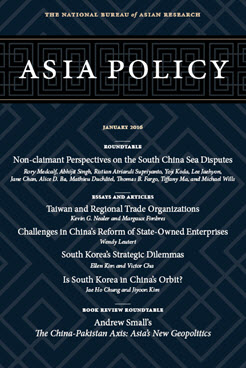India's Strategic Stakes in the South China Sea
This essay is part of the roundtable ” Non-claimant Perspectives on the South China Sea Disputes.”
In the wake of the U.S. Navy’s recent freedom of navigation patrols in the South China Sea in November 2015, maritime stability in Southeast Asia has been a hot topic of discussion in Asian strategic circles. The passage of USS Lassen within twelve nautical miles of Subi Reef in the Spratly Islands group was followed with a fly-by over the same area by U.S. B-52 bombers, leading to fears of an escalation in tensions between the United States and China.
Despite some commentary that deemed the naval patrols as a needless provocation, [1] many regional analysts saw the patrols as an essential undertaking—important to highlight an issue of maritime principle to China. [2] Washington, proponents held, was well within its right to warn Beijing of the illegality of its reclamation in the South China Sea, as well as to underscore the invalidity of its territorial claims in the vicinity of artificially constructed islands. Unsurprisingly, many regional states came out in support of the U.S. decision to challenge China’s island building. Notwithstanding its vastly improved strategic relations with Washington, New Delhi, however, surprised regional watchers by maintaining a studious silence. This essay examines India’s understanding of the South China Sea disputes and assesses the implications of instability in this critical region for Indian interests and the Indo-Pacific more broadly.
India’s Perspective on the South China Sea
India’s reluctance to endorse a maneuver meant expressly to emphasize access to the maritime commons appeared odd since it lately has been vocal about the need to ensure freedom of navigation in the South China Sea, even raising pointed concerns over the growing state of insecurity in the region. [3] New Delhi, however, remains acutely conscious of its official position of neither being party to the disputes nor taking sides. [4] Regardless of the magnitude of nautical developments in the region, India’s security establishment fears that the perception of abandonment of its neutrality might be construed as strategic support for the United States—still the principal source of resistance to Chinese unilateralism in the South China Sea, but whose deterrence strategy, Indian analysts suspect, could spark an intense reaction from Beijing.
Yet there is no mistaking a sense of exasperation in New Delhi with China’s maritime practices in East Asia, which many officials privately regard as being arbitrary and unreasonable. The aggressiveness with which China has sought to protect its turf in the South China Sea has led Indian strategists to believe that, unless sustained pressure is brought to bear upon China, a negotiated solution to the dispute is unattainable. [5] Not surprisingly, in at least three ASEAN-centric forums since the U.S. naval patrols, Indian leaders have emphasized the need for freedom of navigation, the right to passage and overflight, and peaceful resolution of disputes in accordance with the United Nations Convention on the Law of the Sea (UNCLOS).
In November 2015, Prime Minister Narenda Modi made a reference to the South China Sea conflict in two successive events—at the thirteenth ASEAN-India summit and during a public lecture in Singapore—suggesting the need for a mechanism that could enhance cooperation in maritime security, counterpiracy, and humanitarian and disaster relief. [6] India also was widely reported to have snubbed China during the third meeting of the India-Philippines Joint Commission on Bilateral Cooperation in New Delhi…
Endnotes
[1] Sam Bateman, “What Is the U.S. Protesting in the South China Sea?” East Asia Forum, October 20, 2015, http://www.eastasiaforum.org/2015/10/20/what-is-the-us-protesting-in-the-south-china-sea.
[2] Richard Javad Heydarian, “Showdown in the South China Sea: America Takes On China,” National Interest, October 27, 2015, http://nationalinterest.org/feature/showdown-the-south-china-sea- america-takes-china-14173.
[3] Ajai Shukla, “Echoing Modi-Obama Agreement, Parrikar Calls for Freedom of Navigation in South China Sea,” Business Standard, November 4, 2015, http://www.business-standard.com/article/economy-policy/echoing-modi-obama-agreement-parrikar-calls-for-freedom-of-navigation-in-south-china-sea-115110401068_1.html.
[4] Rumel Dahiya and Jagannath Panda, “A Tale of Two Disputes: China’s Irrationality and India’s Stakes,” Institute for Defence Studies and Analyses, Policy Brief, June 29, 2015, http://www.idsa.in/policybrief/ATaleofTwoDisputesChinasIrrationalityandIndiasStakes_rdahiya_290615.
[5] C. Raja Mohan, “Raja-Mandala: Why Delhi Must Not Be at Sea,” Indian Express, November 3, 2015, http://indianexpress.com/article/opinion/columns/raja-mandala-china-philippines-maritime-dispute-why-delhi-must-not-be-at-sea.
[6] Prashanth Chintala, “At ASEAN, Modi Brings Up South China Sea Issue,” Hindu, November 21, 2015, http://www.thehindu.com/news/national/13th-aseanindia-summit-modi-in-malaysia-refers-to-south-china-sea/article7903998.ece; and “In Singapore Lecture, PM Modi Alludes to South China Sea Dispute,” NDTV, November 23, 2015, http://www.ndtv.com/india-news/oceans-should-not-become-new-theatres-of-contests-pm-modi-1246663.
Abhijit Singh is a Research Fellow at the Institute for Defence Studies and Analyses in New Delhi.
About Asia Policy
Asia Policy is a peer-reviewed scholarly journal presenting policy-relevant academic research on the Asia-Pacific that draws clear and concise conclusions useful to today’s policymakers. Asia Policy is published quarterly in January, April, July, and October and accepts submissions on a rolling basis. Learn more


